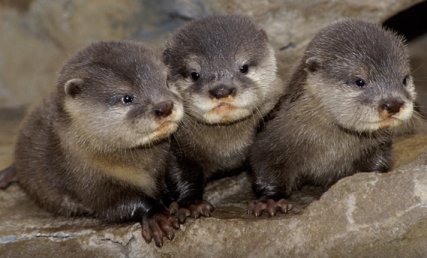Mating and Reproduction
Like other river otters, Lontra
Provocax usually breeds during the winter and spring and
give birth the following year, though numbers for the species
can have a huge variance between actual breeding times and
fertilization. This variance can be between ten to even twelve
months long, but the actual staging for real embryonic
development is along the lines of one to two months.
 When
the pups are born they are helpless, blind, and immobile. They are
completely dependent on the mother for the first few months of
survival. The mother usually has four nipples to feed the young she
may have; the typical river otter gives birth to two to four pups
per breeding season. During the first few weeks the young otters are
always looking for attention and milk from the mother because the
milk is very high nutrition and energy. This high source of calories
and nutrients helps because the young have a very fast metabolism.
When
the pups are born they are helpless, blind, and immobile. They are
completely dependent on the mother for the first few months of
survival. The mother usually has four nipples to feed the young she
may have; the typical river otter gives birth to two to four pups
per breeding season. During the first few weeks the young otters are
always looking for attention and milk from the mother because the
milk is very high nutrition and energy. This high source of calories
and nutrients helps because the young have a very fast metabolism.
They are constantly
needing more nutrients to keep them growing and developing. After
several weeks the newborns are able to open up their eyes and
explore the den. They are still very dependent on their mother for
food and protection for up to three months, after which time the
young otters finally take their first try at swimming. By the time
they reach about four months the young otters have learned how to
fish for themselves and obtain other sources of food. The otters
will stay with their mother for up to a year and then journey on
their own. They will reach sexual maturity within the second to
third year which means they are mature enough to start mating and
begin the process anew.
References:
Cedric, Valmary, and Kari Pihlaviita.
2010 "Lontra Provocax, The Southern River Otter."Http://eol.org/pages/311557/updates.
Encyclopedia of Life. Web. 27 Mar. 2014.
Sepulveda, M., Franco, M., Medina, G.,
Fasola, L. & Alvarez, R. 2008. Lontra
provocax. In: IUCN 2013. IUCN Red List of Threatened Species.
Version 2013.2. <www.iucnredlist.org>.
Downloaded on 27 March
2014.
